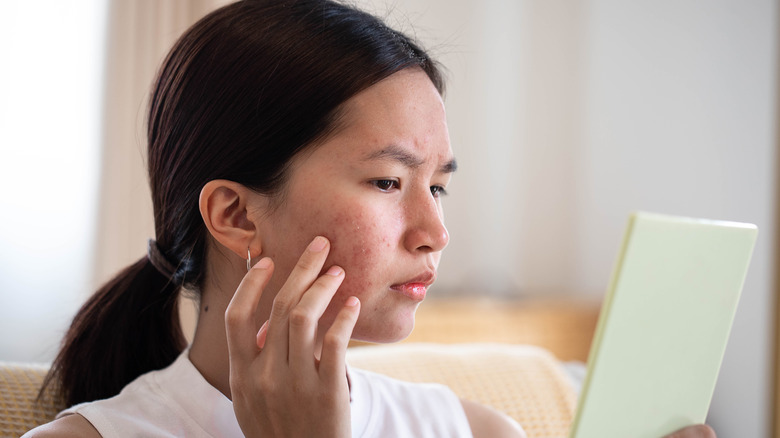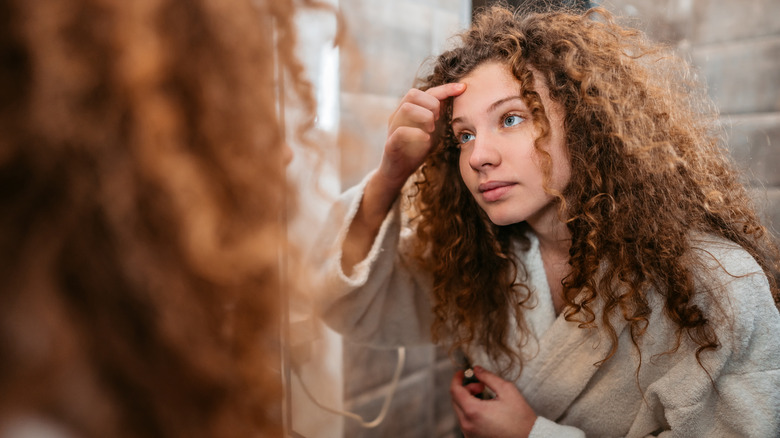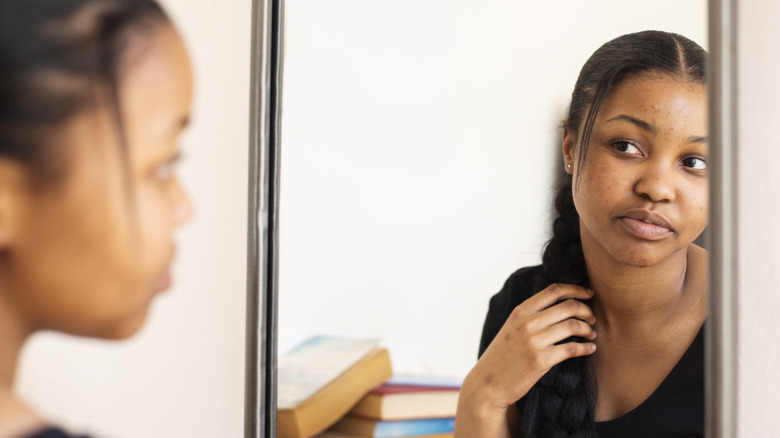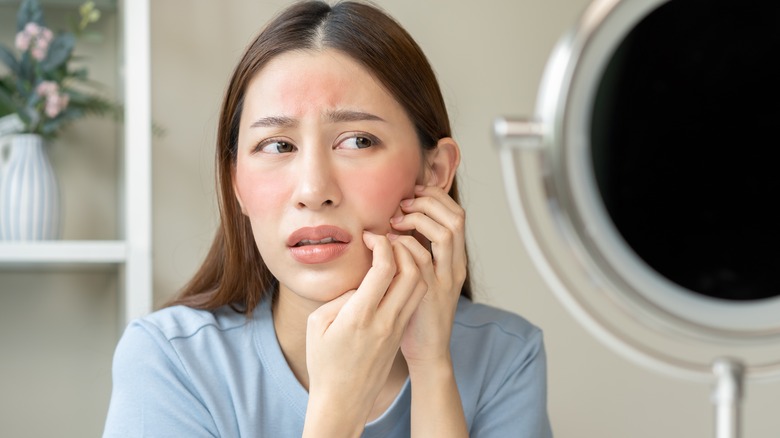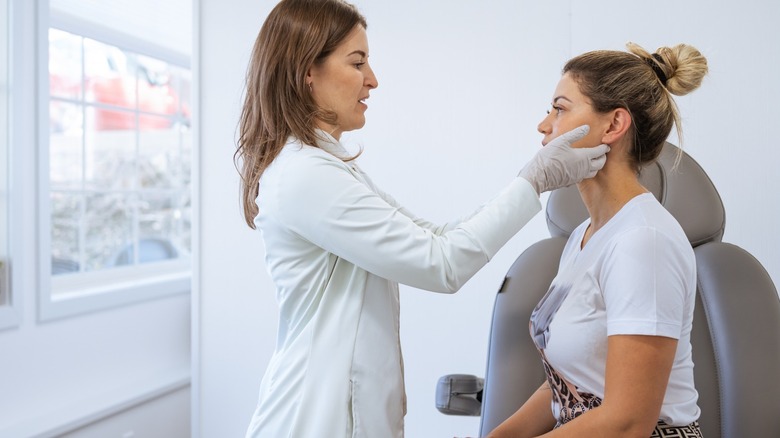Acne Vs. Folliculitis: The Differences, Explained
Waking up to a brand new breakout of small, red bumps on your face or dealing with a seemingly never-ending experience of pus-filled areas of your skin can be amongst some of the most frustrating skincare fights to take on. Likely since around the time you began to notice the first signs of puberty, you also started to experience the not-so-glamorous side effect of acne on your face, shoulders, chest, or back. Since then, every time a breakout seems to occur, the first feelings you have are likely somewhere along a spectrum from dread to disappointment to feeling completely defeated if the bumps just won't disappear.
Upon reaching adulthood, you've probably tried every acne facial cleanser, cream, ointment, and product hoping to rid your skin of pesky breakouts permanently. However, if your acne just doesn't seem to budge and is apparently more stubborn than any treatment option can even touch, then you may not be dealing with acne at all. Instead, you might be experiencing folliculitis. Both acne and folliculitis appear with patches of small bumps which can become red, inflamed, and sometimes contain pus or sebum. Acne and folliculitis are both caused by clogged hair follicles, colloquially called pores, but the underlying causes vary. Knowing the difference can be nuanced and difficult at times, but knowing the respective signs and causes can help you discern the condition. Being aware of recent lifestyle, medication, or hormonal changes can be helpful, though always consult a dermatologist if you have specific questions.
Acne is caused by pores clogged by multiple components
One of the primary differences between acne and folliculitis is the underlying cause of hair follicles becoming inflamed and irritated. To note, there are many subtypes of both acne and folliculitis, but the causes are the same in the majority of cases of each condition. When it comes to acne, the hair follicles on the skin become clogged with buildup from a collection of dead skin cells, bacteria, oil or sebum, pollutants, and dirt, ultimately inflaming pores when the debris is unable to sufficiently exit, according to Mayo Clinic. When the pores, which also contain hair follicles, turn into pustules, then they generally present as whiteheads, blackheads, and nodules or cystic acne which develops deep under the skin. Papules and pustules are superficial, small pimples that form and are commonly considered to come to a head when the pus rises to the top of the clogged pore. Acne is most prevalent in teenagers, though anyone can be affected by the condition for a multitude of reasons. Fortunately, when it comes to acne, there are plenty of options for successfully treating every type using both over-the-counter products and in-office dermatology procedures or prescription medications.
In contrast, folliculitis arises from pores and hair follicles which become inflamed and infected by fungal pathogens or bacteria, most often bubbling up without the additional buildup of sebum, dead skin cells, dirt, and other components frequently found in the clogged pores of acne, says Healthline.
Folliculitis has several frequent causes
Folliculitis is a master of disguising itself as acne, especially if you aren't familiar with the condition and which signs to look for when acne-mirroring bumps appear on your skin. There are numerous types of folliculitis, but most show the basic symptoms of red, irritated, and inflamed patches of skin alongside bumps which are initially small but can be a variety of sizes, reports Cleveland Clinic. Surprisingly, most people experience some type of folliculitis, or irritated hair follicles, at some point in their lives from infancy to old age. When bacteria enters hair follicles or the follicles otherwise become blocked, folliculitis can arise.
Interestingly, folliculitis cannot occur on the soles of feet or the palms of hands, but it can occur on any other area of the body, states American Academy of Dermatology Association. Folliculitis is frequently caused by coming into contact with irritants such as tight clothing or topical products like lotions, moisturizers, and medical ointments, as well as by skin succumbing to injury from overly heated hot tubs, hair removal techniques like shaving and waxing, and plucking individual hair with tweezers. Hot tub and sauna use, plus excessive sweating, are common culprits a healthcare professional will likely ask about if you seek treatment. Folliculitis can also be a side effect of medication or weight gain, so take notes about any recent changes to your medications, lifestyle, or exposure to known folliculitis-inducing factors like specific hair removal methods if you notice potential symptoms.
Visible differences between acne and folliculitis
Writing down your recent lifestyle habits, possible hormonal changes, stress levels, and diet and exercise routines is a great first step to start figuring out if the breakout you're experiencing is acne or folliculitis. Next, put on your spy gear and grab your magnifying glass because the sleuthing work begins!
The good news is that there are some visible hallmarks of folliculitis, but they can be quite tiny or tricky to discern from pure eyesight alone at times. The inflammation of folliculitis is generally far itchier than acne breakouts, plus devoid of sebum when popped, so pay attention if you're tempted to scratch the area, advises Learn Skin. Folliculitis can sometimes create the illusion of red hair follicles when the red hue of skin discoloration is actually occurring around the hair follicles. In comparison, inflamed acne's redness appears on the clogged pores. If you're able to look closely enough to observe skin redness shaped like halos encircling infected bumps rather than redness on the actual infected hair follicles, then you're likely experiencing folliculitis and should consult with a dermatologist, as most cases that don't easily resolve on their own will require antibiotic or antimicrobial treatments to clear the breakout.
Being aware of breakout placement is key, since folliculitis can pop up anywhere while acne is prone to patterns on the upper body, reveals Patient UK. Folliculitis bumps can cause burning sensations in addition to itching, another sensory component more common to folliculitis than acne.
A dermatologist can determine which bacteria is present
While inflamed hair follicles resulting from acne are filled with numerous components, folliculitis causes similarly inflamed, irritated, and red bumps from specific types of fungal infections and bacteria. Properly and effectively treating folliculitis requires knowing the bacteria or fungal pathogen that's causing the infected hair follicles, since antibiotics or topical treatments may be required for eradicating the infection. Cleveland Clinic shares that common bacterial and fungal causes of folliculitis include the strains sycosis barbae and pseudofolliculitis barbae (often called razor bumps or shaving folliculitis), staphyloccocus aureus, malassezia, and pseudomonas aeruginosa, which is commonly called hot tub folliculitis.
When in doubt about a patch of skin with red, inflamed bumps, it's always best to schedule an appointment with a dermatologist who can perform a bacterial swab to test for which type of bacteria or substance is causing the breakout you're experiencing, per Mayo Clinic. Typically, this process includes the medical professional taking a small sample of the pus by means of a cotton swab or other device, or utilizing a medical-grade tool to very thinly scrape some of the skin cells and bacteria from the area to then send off for bacterial testing. Often, dermatologists can assess folliculitis without these measures, while other times your healthcare provider may suggest a skin biopsy to double-check for other conditions aside from acne and folliculitis.
